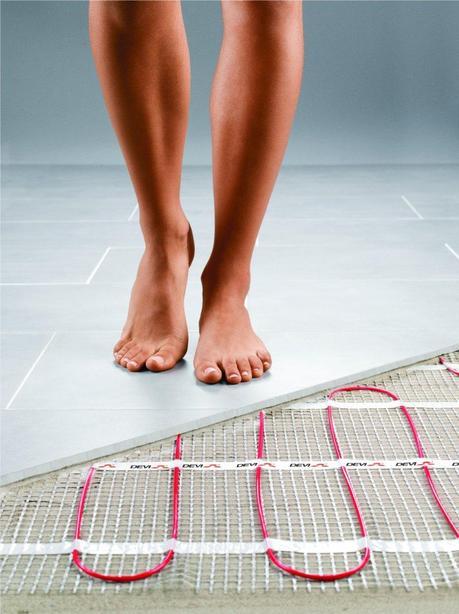Waking up in the morning and beginning that torturous journey to the bathroom only to find an ice cold floor there to greet you. Chances are, the freezing bathroom can sometimes have you hiding under the sheets dreading the minute your alarm clock is set to sound off. That may be a bit of an exaggeration, but this is the feeling that a cold bathroom can give you.
Heating the entire house is not always a feasible option when you consider rising utility costs. How then, are we to keep ourselves comfortable during the approaching fall and winter seasons? Well, we have several inexpensive ideas that you can try out! The best method may depend on your personal living circumstances and the climate you live in.
Infrared Lamp
Infrared lamps, aka heat lamps, are an excellent source of heat that is relatively simple and easy to install. Heat lamps typically utilize 250W incandescent light bulbs that have the ability to produce infrared radiation. When standing directly under one of these bulbs, it will feel like beaming sunrays on a warm summer day (imagine that).

Bathroom Heat Lamp (via: Apartment Geeks
These small bulbs are surprisingly affective at providing a satisfying level of warmth. While the parts are inexpensive, you may need to hire an electrician or handyman to run a power line from your bathroom to your homes electrical panel. Aside from this initial installation costs, a heat lamp is the most inexpensive way to get set up a heating system for a small bathroom without blowing your budget!
Towel Warmer/Space Heater
Towel warmers have been used as space heaters for decades but they have become increasingly recognizable because more homeowners are using them in locations aside from the bathroom! Towel warmers are not only affective heating sources, they can be quite appealing and artistic. There are two types of space heaters that you can choose from; Electric and Hydronic.
Electric space heaters have a low consumption rate, typically that of a 60W light bulb. Towel heaters can run you anywhere from a couple hundred dollars to a couple thousand depending on your style, preference, and taste. These space heaters come in different sizes, allowing you to find one with just enough heat for your application. Available in either hard-wire models or simple plug-ins, you can integrate these heating systems into your electrical wiring or just plug them into a standard 120v outlet!

Towel Heater aka Space Heater (via: diyNetwork)
Hydronic space heaters share a very similar radial tubing construction, but the heating process works a bit differently. As the name hints, hydronic heaters run hot water throughout the hollowed tubing to generate heat. Hydronic heaters are the most efficient sources of heat but initial installation costs can be a bit hefty. Being that they can require you to connect your space heater to your homes water heater, installation can be quite cumbersome and necessitate the help of a professional contractor. On the plus side, hydronic heaters have been praised for their ability to naturally reduce moisture, humidity, and also prevents mildew!
Radiant Floor Heating
Is your bathroom giving you cold feet? Radiant Floor Heating (RFH) utilizes some of the same concepts of space heaters, except these techniques are applied to your bathroom flooring. Using either electrically heated coils or water-heated tubing, RFH can be patterned underneath your bathroom flooring to heat up the room.

Radiant Floor Heating (via: housemaniacos)
Although the required materials are relatively inexpensive, we suggest this method be used when you don’t mind digging up your existing flooring. If you’ve been due for a small bathroom remodel, then it would be a great time to update your flooring and install RFH underneath while you’re at it!
Additional Tips
Before you get started, it’s important to take the necessary steps to ensure that exterior walls, ceilings, and flooring are properly insulated to avoid “chasing your tail.” Seal any cracks that may be allowing hot air to escape. If you don’t insulate the room to be air-tight, your money is literally “slipping through the cracks.” Be sure to do this before you implement any additional heating sources. Insulation is the first and primary step to fighting the cold in your bathroom!
About this Post
Cheryl Khan is a jovial, free-spirited writer who doesn’t believe in boundaries. She is an adventurous soul who enjoys contributing to various blogs that detail unique aspects of home style & decor.
